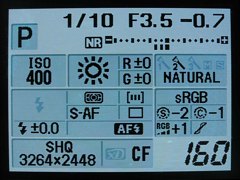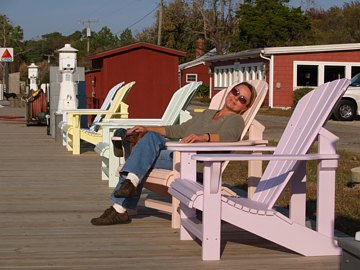.jpg)
.jpg)
|
Olympus E-500 A Digital SLR for the Rest of Us |
|
The Christmas is coming, you've been good the whole year, and Olympus just released the new E-500 — a very attractive digital SLR at a very attractive price. This may be a good time for OM-series aficionados to try out the digital technology, or to upgrade from your non-SLR digital model. This is not an in-depth review of the E-500 — you can find that on my Web site, with more detail than you care about. Here I want to give you just the general idea about this camera, slanted towards the Quest readership. E-500 is the third model in the current Olympus SLR line-up (not counting the fixed-lens, revolutionary E-10 and E-20 of some years ago). It follows the E-1 (pro-grade, weatherproofed, built like a tank, but a bit too large and too heavy for my taste) and the E-300 (a great camera with a somewhat non-orthodox shape and controls which could be improved). Both these were capable of really good results, and in this iteration Olympus decided to keep the technology, but modify the ergonomics and interface. Did they succeed? You bet. |
.jpg)
|
.jpg)
| |
| (Promotional pictures by Olympus) | ||
|
The first thing visible is the new camera shape, a return to the "classic" pentaprism hump (although the camera uses a mirror system for viewing). This makes the E-500 much alike the competing models from other makers; indeed, hard to tell apart from the Maxxum/Dynax 5D. It also improves the camera's balance in your hand. The body is surprisingly light (polycarbonate plastic over a lightweight inner metal frame) at just 435 g (without batteries). Compare that with 665 g for the E-1 or 580 g for the E-300. Obviously, the feel and finish are not up to the standards set by those models, but the camera does not feel cheap as most of the competition, and the plastic finish is quite nice, better than that of the C or N models in the same price range. Another instantly obvious new feature is the large, (63 mm diagonal) LCD monitor on the back. Compared with the 45 mm on the E-1 and E-300 this is a visible improvement, especially with 215,000 of pixels (against 135,000). And, as you will see shortly, those monitor pixels were put to good use here. Internally, the circuitry does not seem much changed from the E-300, and this is a good news, as the latter was capable of delivering some real eye candy. The CCD image sensor is the same, an eight-megapixel model by Kodak, and most of the specs look similar. The most significant changes can be seen in control placement and operation, and, to a lesser extent, in camera customization options. Here Olympus was able to address a great majority of issues I had with the E-300 (which, let me make it clear, I already liked a lot); as a matter of fact, they took care of practically all complaints, a dozen or so, which I had about that camera. A very nice surprise. |
|
Almost all basic controls are accessible via the "press-and-turn" interface (the process momentarily turns on the LCD monitor, as the E-500 does not have the low-power, B&W status display). The less-basic, but still often needed, settings previously required digging into the menu system, discouraging the users from accessing them in the field. Not any longer: the E-500 offers a gorgeous Control Panel on its color monitor, and that panel allows you to change all shooting settings in a very intuitive way: use the arrow keys to highlight the setting, then turn the wheel to change it. Hallelujah! No more need to remember which setting is in which menu, and the process becomes faster and less painful. Only one group of settings (those related to bracketing in a number of parameters: exposure, color, etc.) still requires going into the menu system. Besides that, the improvement is clear; I really started appreciating it only after some time spent with the camera. Small joys of life. |


|
|
You will still have to use the menus to adjust the camera to your preferences, but this is not really a problem: you do it once and keep the setup that way. (Resetting the camera to one of two available custom presets is also done from the menu.) One of the nice touches is the inclusion of three "Picture Modes": Vivid, Natural, and Muted. In addition, each of these has its own adjustments in terms of in-camera sharpness, color, contrast, and tonality, and the camera remembers these for each mode. Think of it as having three different kinds of film, each separately customizable, between which you can switch as needed. Nice. The camera's specifications are as you would expect: exposure automation in aperture/shutter priority and (shiftable) program, ISO adjustment between 100 and 400 (settings above that are optionally accessible but noisy), shutter speeds up to 1/4000 s. Let me save you the details; you can find those in the promotional materials (or in my review). The autofocus is at least as good as that in the E-300 (read: fast and accurate, and the low-light sensitivity has been extended, according to my informal tests). This is the first Olympus digital SLR with the new metering system, using a 7x7 sensor matrix. (This change does not seem to offer any real improvement in highlight protection; you still have to apply exposure compensation as needed for a particular scene, but this is not a problem for a moderately advanced photographer.) The only real complaint I have about the E-300 is the viewfinder. The magnification is 10% less than in the E-1 and E-300, which is not a problem in framing your image, but it makes manual focusing a wishful thinking rather than a feasible option. This is not a big deal for those who rely on AF lenses, but if you have amassed a collection of OM Zuikos and want to use them with the optional OM->4/3 adapter, be prepared for a hard time: this is not the OM-1 focusing screen. (Facts of life: a bigger screen would be darker; to make it brighter you allow for more transparency, thus losing some focusing accuracy; there are no free lunches.) Here we come to the bottom line: the image quality. I was expecting that to be as good as with the E-300, and I wasn't disappointed here. After six weeks with the camera, I am still mighty pleased. First of all, even the "budget" Olympus ZD optics (14-45 and 40-150 mm zoom lenses bundled with the E-500) deliver enough sharpness for the 8 MP sensor to take advantage of. While five megapixels in the E-1 is enough for nice 30x40 cm prints, the extra 30% in resolution allows for more aggressive cropping if needed. Color rendition is, as we grew to expect from Olympus, very good, including skin tones. While usually there is too much saturation in the default Vivid mode (a nod towards the mass market, bordering on garish in some cases), the Natural mode works just the way I like. As with all digital cameras, you will get the best results when setting the white balance manually to one of the available presets. (Yes, I've given up on Auto WB some time ago, and I would recommend that for everyone except complete newbies.) For critical applications, the reference WB setting off a white sheet of paper delivers outstanding accuracy. |

|

| |
| ZD 14-45 mm zoom at 45 mm, program (-0.7 EV): 1/500 mm at F/11, ISO 200, manual WB (sunny), Vivid mode, low contrast and sharpness. See also full size. | ZD 40-150 mm at 118 mm, program (-0.3 EV): 1/160 s at F/4.2, ISO 200, manual WB (sunny), Normal mode, low contrast and sharpness. See also full size. | |
| Postprocessing (both full-size images): very slight (less than 5%) cropping, a tad of equalization, slight sharpening. For more samples (without any postprocessing) see my E-500 sample page. | ||
|
The noise at ISO 100 and 200 seems to be low, certainly lower than with films of those speeds; ISO 400 is still good (I sometimes use that setting even in the daylight, especially with longer lenses). The "extended" ISO 800 setting is still usable, while the top ISO 1600 — barely so. Olympus is quite conservative with dynamic noise reduction, and I prefer that to the plastic-wrap look of some cameras boasting lower noise, so I don't mind this. (The E-500 allows you to activate more aggressive filtering at higher settings, but the court is still out on this matter.) While I bought the E-500 as the second body to go along with the E-300 (which delivers very similar results), I found myself shooting with the new camera most of the time: it is so much more intuitive and faster in use. The whole operation is quite transparent, the way it should be: you can focus on your pictures, not on the settings. The E-System is by now quite mature, offering a dozen or so lenses, ranging from an 8 mm fish-eye to 300 mm, F/2.8 super-tele (translate that into 16 mm and 600 mm for a 35-mm film camera). These are premium pieces of glass, with prices to match, but the offer also includes some less expensive zooms of respectable quality. The flash options range from a TTL macro ring light to the very nicely specified FL-36, with zoom, swivel and bounce, and full TTL exposure automation; I like the latter a lot. With the very aggressive pricing (the kit with two zoom lenses mentioned above sells in the States for $900 or less) Olympus is making an offer hard to refuse — even if you are a hard-core OM user, reluctant to go digital. Besides, you can always put an E-500 side-by-side with your treasured OM-1 (or, if you are really lucky, the M-1), look at them, and think of the technology progress in the last 30 years, for better or worse. Or you can just grab the E-500, go outside shooting and have some great prints the same night. In either case, you will get your money worth.
|
|
This article was originally published in Quest, the quarterly newsletter of the Olympus Circle; December, 2005. |
| Home: wrotniak.net | Search this site | Change font size |
| Posted 2006/03/12 | Copyright © 2005, 2006 by J. Andrzej Wrotniak |